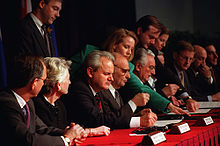Dayton Agreement
| Dayton Agreement | |
 Seated from left to right: Slobodan Milošević, Alija Izetbegović, Franjo Tuđman signing the final peace agreement in Paris on December 14, 1995. | |
| Created | December 14, 1995 |
| Signatories | Slobodan Milošević, Alija Izetbegović, Franjo Tuđman |
| Purpose | Ended the Bosnian War |
| Bosnia and Herzegovina |
 This article is part of the series: This article is part of the series:Politics and government of Bosnia and Herzegovina |
| |
| Other countries · Atlas Politics portal |
- "Dayton Treaty" redirects here. For the Native American treaty, see Treaty with the Kalapuya, etc.
Contents[show] |
[edit] Background
[edit] Decision of the Constitutional Court of Bosnia and Herzegovina
(...) the Constitutional Court is not competent to evaluate the constitutionality of the General Framework Agreement as the Constitutional Court has in fact been established under the Constitution of Bosnia and Herzegovina in order to uphold this Constitution (...) The Constitution of Bosnia and Herzegovina was adopted as Annex IV to the General Framework Agreement for Peace in Bosnia and Herzegovina, and consequently there cannot be a conflict or a possibility for controversy between this Agreement and the Constitution of Bosnia and Herzegovina.[3]
